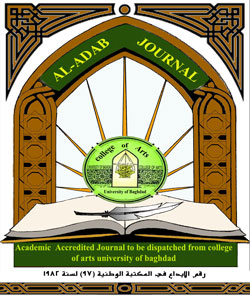Some variables affecting the Attitudes of University students attitudes towards the Political Participation of Women in Four Arab Societies
DOI:
https://doi.org/10.31973/aj.v0i133.740Keywords:
women, youth, political participation, attitudes, Arab worldAbstract
This study aims to identify attitudes of university students towards the dimensions of women’s political participation in four Arab societies. It also aims to examine the impact of some socio-demographic and economic variables on those attitudes.
To achieve the aims of the study and answer research questions, a sample of university youth was randomly selected in four Arab universities (UAE, Jordan, Sudan and Algeria) to fill out a questionnaire; a total of 1773 questionnaires were completed. Descriptive statistics (percentages, means, and standard deviations) and analytical statistics (multiple linear regression) were applied in the analysis of the study data.
Descriptive analysis of the data has revealed positive attitudes of university youth towards the political participation of women in Arab societies. However, these results differ in relation to the specific dimensions of political participation: Arab university youth hold more liberal attitudes towards women's participation in civil society compared to their participation in the political process and their political status. Meanwhile, results of the inferential statistical analysis have shown that certain variables, namely country, gender, age, college, mother's educational level, and religiosity have statistically significant relationships with all or some dimensions of political participation of Arab women.
Downloads
References
European Union (2010) Report on the analysis of the national situation: women's human rights on the basis of gender (Algeria).
United Nations Development Programme. 1993. Human Development Report 1992
Salah, Suhair. 2012. The development and future of political participation of Sudanese women. Women's Studies Center: Khartoum
Al-Othman, Husein (2004) The Political Participation of Jordanian Women. Unpublished study.
Chitoy & Dagestani. 1998. The Political Participation of Islamic Women Amman: Dar Al-Amal for Publishing
Naqshbandi, Bari'ah (2001) The Political Participation of Women in Jordan and Some Arab Countries, Beirut: The Arab Institute for Studies and Publishing.
Ademiluyi, Israel and Siyanbola (2010) gender analysis of political participation in Nigeria. Journal of Law and Psychology, 55-60.
Almond, Gabriel A., and Sidney Verba (1963) The Civic Culture: Political Attitudes and Democracy in Five Nations, Princeton: Princeton University Press.
Al-Othman, Husein (2011) Attitudes toward women’s participation in public life in the UAE. International Journal of Women’s Studies, 12 (3), 234-246.
Badri, balghis & ElNaggar, Samia. 2013. The introduction of the Quota System in Sudan and its Impact in Enhancing Women’s Political Engagement. Ahfad University for women.
Bollen, Kenneth and Pamela Paxton (1998). Detection and determinants of bias in subjective measures, American Sociological Review, 63.
Howell, Jude. 2006. Women’s political participation in China: in whose interests election?, Journal of Contemporary China, 15 (4,): 603-619.
Jimenez, Antonia (2009) Women and decision-making participation within rightist parties in Portugal and Spain. Analise Social, XLIV, 235-263.
Ondercin, Heather and Daniel Jones – white (2011 ) . Gender Jeopardy : what is the impact of gender differences in political knowledge on political participation? Social Science Quarterly, 92 (3): 675-694.
Sagot, Montserrat (2010).Does the political participation, affirmative action and quotas in costa Rica. Institute of Democratic Studies Bulletin .41 (5):25-34.
Braud, Philippe. (2008). Sociologie Politique 11e Edition.LGDJ Lextenso Editions.
Neaga, Diana (2014) Political participation of women in Romania: a bottom-up approach. Romanian Review od Social Sciences, 6: 60-77.
Downloads
Published
Issue
Section
License
Copyright and Licensing:
For all articles published in Al-Adab journal, copyright is retained by the authors. Articles are licensed under an open access Creative Commons CC BY 4.0 license, meaning that anyone may download and read the paper for free. In addition, the article may be reused and quoted provided that the original published version is cited. These conditions allow for maximum use and exposure of the work.
Reproducing Published Material from other Publishers: It is absolutely essential that authors obtain permission to reproduce any published material (figures, schemes, tables or any extract of a text) which does not fall into the public domain, or for which they do not hold the copyright. Permission should be requested by the authors from the copyrightholder (usually the Publisher, please refer to the imprint of the individual publications to identify the copyrightholder).
Permission is required for: Your own works published by other Publishers and for which you did not retain copyright.
Substantial extracts from anyones' works or a series of works.
Use of Tables, Graphs, Charts, Schemes and Artworks if they are unaltered or slightly modified.
Photographs for which you do not hold copyright.
Permission is not required for: Reconstruction of your own table with data already published elsewhere. Please notice that in this case you must cite the source of the data in the form of either "Data from..." or "Adapted from...".
Reasonably short quotes are considered fair use and therefore do not require permission.
Graphs, Charts, Schemes and Artworks that are completely redrawn by the authors and significantly changed beyond recognition do not require permission.
Obtaining Permission
In order to avoid unnecessary delays in the publication process, you should start obtaining permissions as early as possible. If in any doubt about the copyright, apply for permission. Al-Adab Journal cannot publish material from other publications without permission.
The copyright holder may give you instructions on the form of acknowledgement to be followed; otherwise follow the style: "Reproduced with permission from [author], [book/journal title]; published by [publisher], [year].' at the end of the caption of the Table, Figure or Scheme.











